
Although European airliner makers were generally trounced in the market by American giant Boeing during the 1960s, in the course of that decade they worked towards a collaboration to fight back, which emerged as the "Airbus" consortium. The initial Airbus offering, the "A300", flew in the 1970s; after a shaky start, it became a serious competitor to Boeing's jetliners. This document provides a history and description of the Airbus A300, as well as its shortened "A310" and stretched "A330 / A340" derivatives. A list of illustration credits is included at the end.
* Europeans had been innovators in jet airliner design, with the British developing the pioneering de Havilland Comet airliner in the early 1950s and the French developing the innovative and elegant Sud-Aviation Caravelle a decade later. However, the US giant Boeing was able to take control of the jetliner market and all but shut Europe out. The British and French did manage to take a leap ahead by developing the Concorde supersonic transport (SST), but although the Concorde was a technical marvel, in business terms it proved a dismal failure when the projected market for SSTs didn't pan out.
In June 1965, during the Paris Air Show, the leading European airlines -- including Air France, Alitalia, British European Airways (BEA), Lufthansa, Sabena, and SAS -- met to discuss their future requirements for airliners. Their requirements generally focused on a short to medium range mid-sized airliner to service their routes. The envisioned type was simply regarded as an economical people-hauler, and was often referred to as an "airbus".
German and French aircraft manufacturers also had a meeting to discuss airbus concepts. The German companies -- including ATG Siebelwerke, Boelkow, Dornier, Flugzeug-Union Sud, HFB, Messerschmitt, and VFW -- were more interested in the idea at the time than the French participants, and a few weeks later the Germans formed up an informal group named "Studiengruppe Airbus", later renamed "Arbeitsgemeinschaft Airbus", to give more thought to the matter. The group members were particularly interested in the new high-bypass turbofan engines being developed in the US and Europe, which offered high subsonic thrust with impressive fuel economy and would be ideal powerplants for an airbus.
In the meantime, in October 1965 the European airlines held another meeting, this time in London, on the airbus concept. The British and French governments formed up an "Anglo-French Ministry Working Party" to see what they could do to push things along, releasing an airbus specification late in 1965. The goal was a 200- to 250-seat jetliner with a range of 1,500 kilometers (930 miles / 810 NMI), a figure which was later increased to 2,220 kilometers (1.380 miles / 1,200 NMI), with operating costs to be 30% lower than that of the Boeing 727-100. Of course, the airbus would have modern turbofans, such as the Pratt & Whitney (P&W) JT9D or Rolls-Royce RB.178, to obtain such economies.
With British government encouragement, the Hawker Siddeley (HS) company began discussions with Breguet and Nord of France to come up with airbus design concepts. The group, known as "HBN" after the initials of its members, generated five concepts, one of which, the "HBN.100", emerged as a front-runner. It was a twinjet airliner with a single-deck fuselage featuring a circular cross-section. It had a 6.1-meter (20-foot) diameter, matching the width of the emerging Boeing 747 jumbo jet, to allow carriage of the same containers as the 747.
In early 1966, the French Sud Aviation and Dassault firms joined forces to come up with their own airbus concepts. Sud had previously come up with a twinjet concept they called the "Grosse Julie", and adapted it to fit the Anglo-French government requirement. All this various activity was encouraging, but it needed some direction to get on track to actually building something. An agreement was established between the three member states, with each nation designating a company to participate in further airbus discussions -- Britain picked HS, France picked Sud Aviation, and Germany picked the Arbeitsgemeinschaft Airbus group.
Formal requests for funding were submitted to the governments of the three member states on 15 October 1966. The Airbus concept had grown somewhat over the year to envision a jetliner with 320 seats, and so the projected aircraft was given the designation of "A300", for "Airbus 300 seats". In May 1967, the partnership arrangement was clarified, with Britain and France each to bear 37.5% of the cost and Germany picking up the other 25%. Sud Aviation would be responsible for the design of the A300, while Rolls-Royce would build the new RB.207 high-bypass turbofan to power it.
The arrangement was formalized at a meeting of the governments of the member states in London in July 1967. The actual program launch was not supposed to happen until the airlines of the three member states -- Air France, BEA, and Lufthansa -- committed to buying at least 75 aircraft. The launch target was June 1968, but that date passed without any commitment from the airlines. One of the problems was apparently the uncertainty of the airlines over the RB.207 engine development program. Roger Beteille, head of the Sud Aviation A300 design team, went to the UK to talk with Rolls engineers and get a feel for how well the effort was going. He decided that it wasn't going anywhere, that Rolls was using British government funds being provided in principle for the RB.207 to develop the smaller RB.211 turbofan for the US Lockheed Tristar three-jet jumbo airliner.
When Rolls was awarded the contract to supply RB.211s for the Tristar, Beteille decided it was time to walk. He had no assurance that the British government would fund full development of the RB.207 in parallel with the RB.211, or if Rolls would bother with the RB.207 even if the funding was provided. Beteille walked very softly, however, working quietly to refocus the design effort into something that better reflected realities. Incidentally, Beteille was wise to walk, since the RB.211 program drove Rolls into bankruptcy in 1971, apparently due to a combination of technical difficulties and an arcane shift in exchange rates between the UK pound and the US dollar. It put the Tristar program in a difficult situation, from which it never fully recovered.
Beteille's design team came up with a smaller 250-seat jetliner that allowed replacement of the RB.207 with available fanjets, such as the P&W JT9D, the RB.211, or the General Electric (GE) CF6-50. Fuselage width was cut to 5.54 meters (18 feet 2 inches), though it was later pushed back out to 5.64 meters (18 feet 6 inches), and the length was cut from 53.94 meters (176 feet 11 inches) to 48.32 meters (158 feet 6 inches). At the end of 1968, the engineering team unveiled the new design, which was named the "A300B" to emphasize its commonality with the old concept, instead of its differences.
The French and German partners remained enthusiastic about the program, and in fact liked the A300B concept because it potentially increased American content in the aircraft. This might have seemed contrary, but to really make a success of the Airbus, it would have to be sold to US airlines; adding significant American content promised to make it more appealing to those customers, as well as head off inclinations by the US government to raise barriers to sales of the type.
However, British enthusiasm cooled considerably. Some sources hint that one of the reasons was that the RB.207 had been eliminated from the design, though since Rolls really wasn't working on the RB.207, that reasoning seems a bit hard to follow. In any case, the British government officially dropped out of the program on 10 April 1969. The French and German governments went ahead and signed a new agreement on 29 May 1969 in which each took a half-share of the program.
In a gutsy move, HS remained in the game using company funds and would be responsible for the wing assemblies. Fokker-VFW of the Netherlands also jumped into the program on their own initiative, and with this combination of forces "Airbus Industrie" was formally established on 18 December 1970. Aerospatiale, which had absorbed Sud Aviation earlier in the year, and Deutsche Airbus both had a 37.5% share in the business, while HS had 20% and Fokker-VFW had 5%.
* The first president of Airbus Industrie was Henri Ziegler, with Beteille as technical director and Felix Kracht, a veteran of the Transall C160 program, as manufacturing director. Kracht was influential in setting up the production scheme. The Concorde effort had focused on setting up separate production lines in France and Britain, but that had been a wasteful duplication of effort. The new scheme involved building subassemblies in various nations and companies, and then bringing them to Toulouse in France for final assembly.
This scheme, known as "light assembly", gave the French something of a leadership position in the Airbus program, but they were placing great effort on it, and Toulouse had more airspace for conducting flight test anyway. Hauling the big subassemblies over road or rail to Toulouse would have been difficult or impossible, but Kracht came up with a scheme to airlift them, using four Aero Spacelines "Super Guppy" conversions of Boeing C-97 Stratocruiser cargolifters. The Guppies were originally designed to haul booster assemblies for the US space program, and they had an oversized fuselage and a swing-open nose. Aero Spacelines was later bought out by Tracor and got out of the Guppy business, and so Airbus bought the plans for the Super Guppy conversion, contracting with UTA of France to build two more of them. The irony of (more or less) a Boeing aircraft becoming an enabling technology for Airbus Industrie was a source of a bit of amusement for Airbus staff.
* Of course, along with the logistical issues there were also cultural differences to deal with in the collaboration. The French would send officials to meetings without empowering them to make decisions, and so the British and Germans got to the point where they would leak ideas beforehand, so the French could arrive with the decisions already largely made. Class-conscious HS officials would go to the all-ranks cafeteria in Toulouse and be shocked to see an Airbus vice-president eating lunch with his secretary. The Germans conducted meetings in a highly structured "Prussian" fashion that the British and French found irritating.
Still, everyone was highly motivated, and the goal was to get the A300B out on time and in budget, which so far hadn't come close to happening with any major European aircraft collaboration. Things were run by a small, tight headquarters in Toulouse that was empowered to make tactical decisions.
The very first Airbus, the "A300B1", made its initial flight on 28 October 1972. It was the first of two prototypes, with the second A300B1 following it into the air on 5 February 1973. The initial flight of the first production type, the "A300B2", later the "A300B2-200", performed its initial flight on 28 June 1973 -- the production machines were 2.85 meters (8 feet 8 inches) longer than the prototypes. French and West German certification was awarded on 15 March 1974, with US Federal Aviation Administration certification on 30 May 1974. The first operational flight was on 30 May 1974, with an Air France shuttle from Paris to London.
* The response was generally a yawn. A Boeing vice president, Jim Austin, described it as a "typical government airplane. They'll build a dozen or so and then go out of business." As arrogant as that sounded, it was not an unreasonable assessment of the situation. It had been true of the Dassault Mercure, which was a Boeing 737 lookalike, and the Hawker Siddeley Trident, which was something like a short version of the Boeing 727; initial sales suggested it was going to be true for the A300B. Despite a worldwide sales tour in 1973, only a few were sold in 1975. The 1973 Mideast October War had resulted in an Arab oil embargo that shot fuel prices sky-high, and the market for new airliners was in the dumps.
In fact, Airbus didn't sell a single airliner for 16 agonizing months. In 1976, Ziegler was replaced by Bernard Lathiere, a graduate of the elite French Ecole National d'Administration. Lathiere was an outgoing sales-marketing type who provided an excellent balance for spare engineering types like Beteille and Kracht. The A300B clearly had promise. Those that were in service got high marks from the airlines. The type was reliable and economical to operate, and well liked by both flight and ground crews.
Things didn't turn around right away under Lathiere. A small deal with Western Airlines fell through, and things were looking very bleak for Airbus. Then, in April 1977, Thai International Airlines ordered four A300s. Eastern Airlines took the bait on an offer from Airbus to operate four A300s for six months on what amounted to a free trial basis, and in April 1978, Eastern ordered 23 A300s. Airbus had been saved, with the sale to Eastern jabbing a pin into Boeing. The last time any major American carrier had bought a European jetliner was in 1964. 70 firm orders were placed in 1978, with 27 options on top of that. The turnaround persuaded the British government to jump back into the program through BAE.
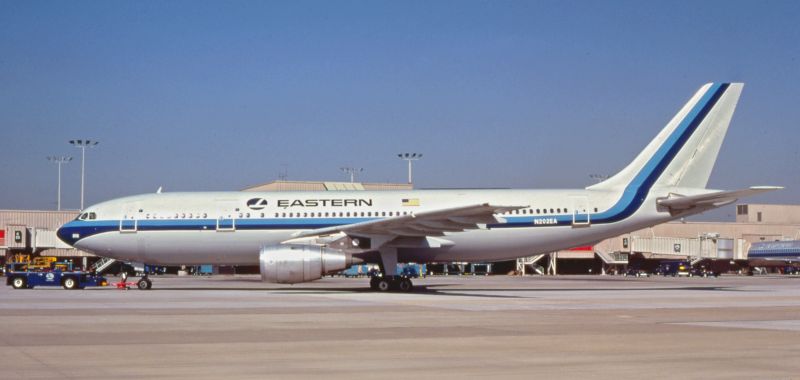
Boeing complained through the US government that Airbus was being unfairly subsidized by European governments, which amounted to an unfair trade practice. Airbus was in fact being supported by the governments of the company's member states, but Airbus replied that Boeing's original jetliner developments had been heavily subsidized by US military contracts. In 1978, Lathiere commented at the Farnborough Air Show in the UK: "I think the Big Bad Wolf is screaming because Little Red Riding Hood has bitten him in the ass."
Those were fighting words. The competition between Airbus and Boeing would never have any resemblance to a friendly rivalry, and Lathiere's comment was hardly the last time that officials of both companies would snipe at each other in front of the press. The dispute would be noisy, mean-spirited, often petty-minded, and always loaded down with politics. It eventually went more or less quiet, but not because of any reconciliation: clients got sick of listening to the two sniping at and spreading nasty rumors about each other, saying they weren't interested in listening to it any more, and they should both kindly, shut, up.
BACK_TO_TOP* The A300B2-200 had a configuration similar to that of a Boeing 737, though the Airbus was a much larger aircraft. It had swept flight surfaces, including a low-mounted wing with a sweep of 28 degrees at quarter-chord and fitted with twin GE CF6-50 series high-bypass turbofans, with versions in the thrust range of 227.4 kN (23.1 kgp / 51,000 lbf) to 240.8 kN (24.5 kgp / 54,000 lbf). The CF6 engines were built under license by SNECMA of France. A Garrett auxiliary power unit (APU) turbine engine was fitted in the tail for ground power and engine starting.
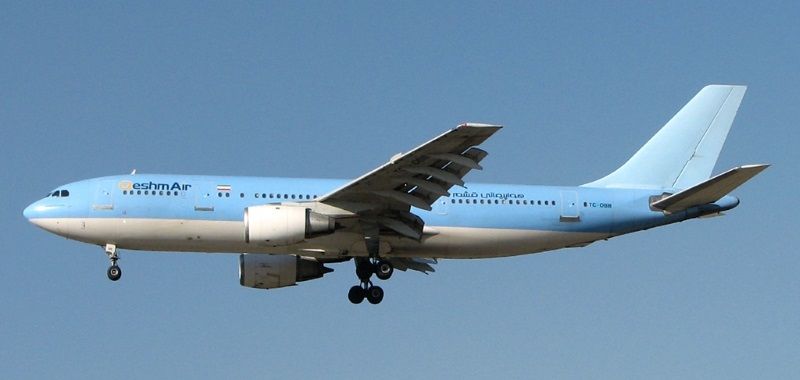
The wing featured full-span leading-edge slats, and double slotted Fowler flaps that increased wing area by 25% when fully extended. The inboard flaps had a single segment, with the outboard flaps having two segments, being separated by an inboard all-speed aileron, complementing a low-speed aileron near the wingtip. There were five-section spoilers ahead of the outboard flaps, with two-section spoilers ahead of the inboard flap, these inboard spoilers being used strictly for lift dumping. The tailplane had elevators, but also was all-moving for pitch trimming.
Flight controls were driven by a triple-redundant hydraulic system. A pop-out ram-air turbine (RAT) could provide hydraulic pressure in an emergency. The nose gear retracted forward and featured two wheels, while the main gear retracted inward from the inboard wing towards the fuselage and had four wheels, in a 2x2 arrangement. There was a bumper under the rear fuselage to protect against tail scrapes.
There were three flight crew. The fuselage had a diameter of 5.64 meters (222 inches), providing two-aisle passenger seating with options for six, seven, eight, or nine seats in each row. That gave 220 seats in a three-class arrangement, to 375 seats in an all-economy "cattle car" arrangement. Typically, there was a galley and toilets fore and aft of the passenger compartment. There were two passenger doors forward, an emergency exit rear of the wing, and a passenger door in the rear near the tail, on both sides of the fuselage. Of course, all accommodations were pressurized and climate-conditioned. Up to 23 standard LD3 containers could be hauled on the lower cargo holds -- one fore and one aft of the wing, with the doors on the right side of the fuselage.
The A300B2 was available in "-100", "-200", and "-300" subvariants with increasing maximum take-off weight (MTOW) ratings. The A300B2 was soon replaced in production with the "A300B4", much the same except for addition of a fuel tank in the wing center section, and a flip-over leading-edge Krueger flap just outboard of the wing root to improve take-off performance.
___________________________________________________________________
AIRBUS A300B4:
___________________________________________________________________
wingspan:
44.84 meters (147 feet 1 inch)
wing area:
260 sq_meters (2,800 sq_feet)
length:
53.62 meters (175 feet 11 inches)
height:
16.62 meters (54 feet 6 inches)
empty weight:
88,500 kilograms (195,100 pounds)
MTO weight:
165,000 kilograms (364,000 pounds)
max speed at altitude:
875 KPH (545 MPH / 475 KT)
cruise altitude:
10,670 meters (35,000 feet)
range, fully loaded:
6,670 kilometers (4,140 MI / 3,600 NMI)
___________________________________________________________________
The A300B4 was produced in "-100" and "-200" subvariants with increasing weight ratings, as well as in specialized configurations:
* The tail assembly of the A310 was transplanted to the A300 to provide more space for two additional seat rows, resulting in the "A300B4-600", though it was generally known as the "A300-600". It performed its initial flight on 8 July 1983 and entered service that year, with an extended-range "A300-600R" featuring a trim tank in the tail becoming standard production from 1989.
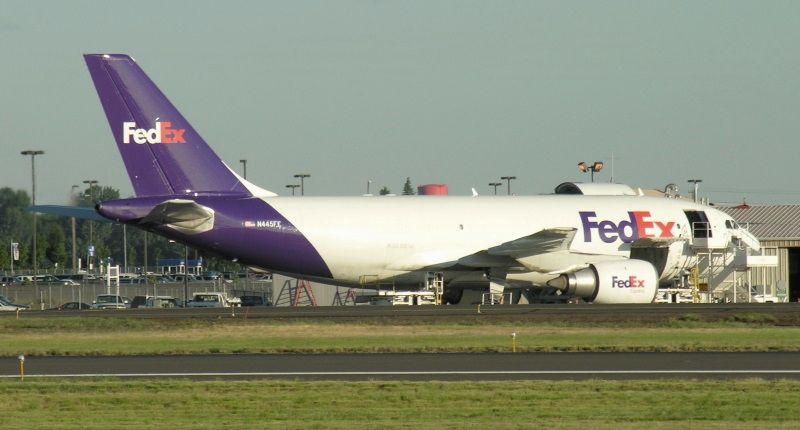
A number of subvariants were built:
Five A300-600 machines were also built as "Super Transporters" to replace the Airbus Super Guppies. The Super Guppies gave good service up to the late 1980s, but they were getting elderly and expensive to keep flying. The first "A300-600ST", better known as the "Beluga", performed its initial flight on 13 September 1994, going into service a year later. It appears all five were new-build aircraft, not conversions as has been the case for most other bulky cargo freighters. They were all powered by CF6-80 series engines.
Another unorthodox feature was that the nose didn't hinge open along with the cockpit, which would have complicated hooking up the cockpit with the rest of the aircraft, and in particular lengthened turnaround time. The cockpit was instead shifted down lower to the ground, with access to the cargo hold via an upward-hinged door. The cargo hold volume was 1,210 cubic meters (43,000 cubic feet), more than that of a Lockheed Martin C-5 Galaxy, but cargo load was a relatively modest 47 tonnes (52 tonnes), well less than half that of the C-5. There was a forward fillet on the tailfin and finlets on the tips of the tailplane. While they are generally used for hauling Airbus assemblies, they are also rented out on occasion to haul other loads.
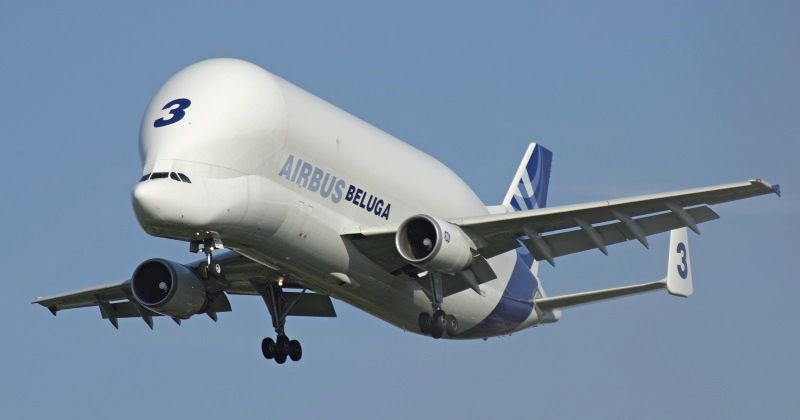
The last A300, a freighter, was delivered in 2007, total production having been 561 airframes. At last notice, fair numbers of A300s remain in service, it seems primarily as air freighters; along with those built as air freighters, a number of A300 airliners having been converted by Airbus to freighter configuration -- designated "P2F" for "passenger to freight". These conversions featured a large upward-hinging cargo door on the front left fuselage; a reinforced cargo floor; cargo-handing kit; window plugs; most of the passenger doors sealed shut; plus other updates, such as an appropriate lighting system. Third parties have offered comparable conversions.
Upgrades to modern "glass cockpits", with color flat-panel displays, have been performed, along with other updates of avionics such as weather radar. The updates have been driven by the difficulty of maintaining old technology, as well as the need to interface with modernized air traffic control systems, with greater reliability and lighter weight being significant factors as well. End users have found that the upgrades quickly pay for themselves in reduced operational costs.
BACK_TO_TOP* Roger Beteille had envisioned all along that the A300 was only going to be the first in a series of Airbus airliners. While other European collaborative aircraft development efforts, like the SEPECAT group that built the Jaguar and the Transall group that built the C160 transport, were one-shot alliances of companies to meet a specific government requirement, Airbus was in business for the long haul. For such a business to make any sense at all, Airbus would have to be able to compete effectively with Boeing. At the time, Boeing had about 60% of the market for jetliners in the West and was making money; McDonnell Douglas had about 30% of the market and was more or less staying afloat. Airbus had to get at least 30% of the market to even survive.
That meant competing more directly with Boeing's product line. In 1975, Beteille quietly circulated one iteration of his proposals around Airbus, envisioning a cut-down "A300B10" with a capacity of 200 passengers, a stretched "A300B9", and a long-range four-jet "A300B11". At that time, with the survival of the A300 very much in doubt, Beteille's notions were little more than speculative. In 1977, with the company on a much firmer footing, such plans were well more realistic, and Airbus publicly announced plans for the 200-seat A300B10, which presently became the "Airbus A310".
Of course, Boeing hadn't been standing still, and was promoting two new twin-jet airliners -- the narrow body Boeing 757 and the wide body 767. Boeing pitched a scheme to the British government in which Rolls-Royce would build the fanjets for the 757; British Aerospace (BAE, which had absorbed Hawker Siddeley) would build the 757 wings; and British Airways would be one of the 757 launch customers. That offer exerted a lot of pull on the British, but Airbus wasn't lacking in pull of their own, and countered with a polite threat that if BAE didn't come on board Airbus Industries as a fully government-backed partner, Airbus would cut the British out of the group and other European nations would take up the slack. The British government compromised, with Rolls-Royce building the engines for the 757 and British Airways buying Boeing, while BAE became a full partner in Airbus -- though BAE would finally bail out in 2006.
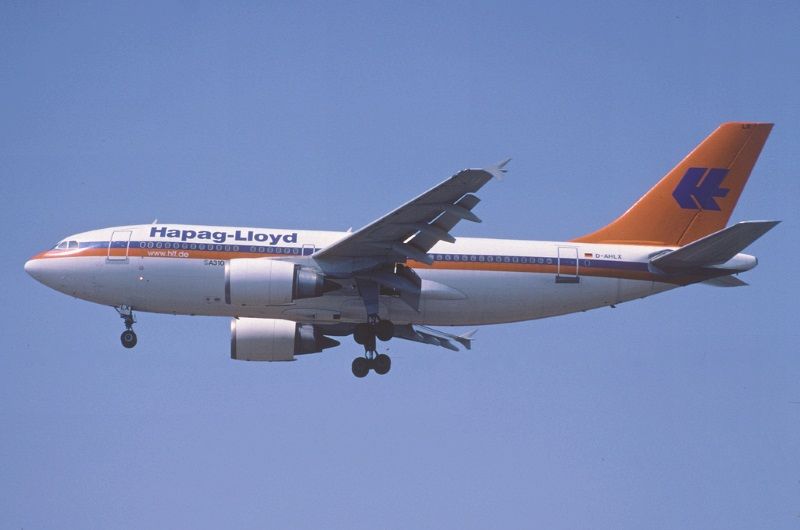
* In any case, the first A310, an "A310-200", performed its initial flight on 3 April 1982. Initial certifications and deliveries took place the next year. The A310 could be described, and certainly looked like, a "shortened" version of the A300; the original concept for the A310 had indeed been minimum change from the A310, but that notion didn't survive close analysis, since it would have resulted in a less efficient aircraft. Along with the shorter fuselage, there were considerable tweaks to the A310 relative to the A300:
Powerplants were either P&W JT9D-7 or GE CF6-80C2 variants, as per customer option, with thrust in the range of 220 kN (22,670 kgp / 50,000 lbf) to 237 kN (24,040 kgp / 53,000 lbf) each. There was two-aisle seating, with three-class configurations running typically to 218 seats, two-class to 240 passengers, and one-class to 280 seats. Door arrangement was similar to the A300, except there was only one passenger door forward of the wing on each side instead of two. It was also available in "-200C" combi or "-200F" pure freighter configurations, with a maximum cargo load of 33 tonnes (36 tons).
___________________________________________________________________
AIRBUS A310-200:
___________________________________________________________________
wingspan:
43.9 meters (144 feet)
wing area:
219 sq_meters (2,360 sq_feet)
length:
46.66 meters (153 feet 1 inch)
height:
15.8 meters (51 feet 10 inches)
empty weight:
80,142 kilograms (176,312 pounds)
MTO weight:
141,974 kilograms (312,342 pounds)
max speed at altitude:
900 KPH (560 MPH / 485 KT)
cruise altitude:
10,670 meters (35,000 feet)
range, fully loaded:
6,800 kilometers (4,225 MI / 3,670 NMI)
___________________________________________________________________
The A310-200 was followed by the "A310-300", initial flight being on 8 July 1985. The A310-300 was externally difficult to distinguish from the -200 and had the same passenger capacity, but featured:
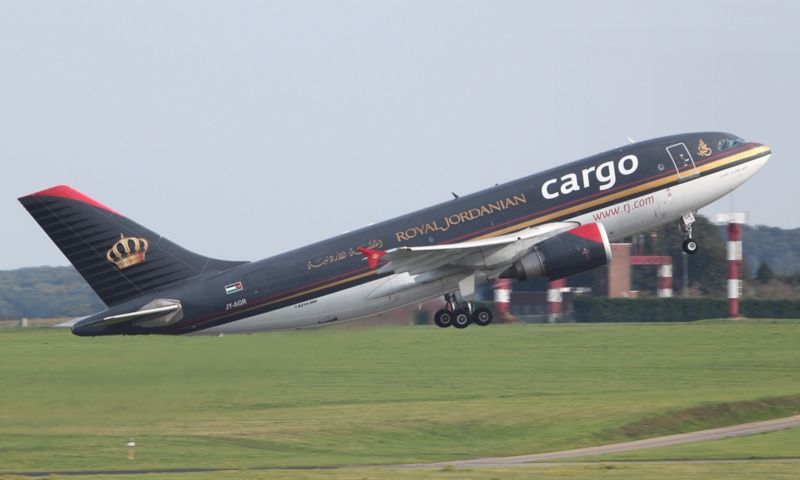
Both "-300C" combi and "-300F" freighter variants were built as well. Military services operated the A310 in various roles, a matter discussed later. The last A310 was delivered in 1998, a total of 255 having been built -- with many A310s still in service having been run through P2F conversions to freighter configuration by Airbus, and third parties offering similar freighter conversions.
BACK_TO_TOP* Roger Beteille retired in 1985, but the plans he set in motion went on. The stretched A300B9 emerged, after considerable gyration, as the "A330" and the four-engine A300B11 became the "A340". The initial "A330-300" performed its maiden flight on 2 November 1992, with six aircraft used in the trials program. One crashed, with loss of all seven aboard, but the A330 was introduced to service in early 1994.
The A330-300 looked much like its A300 ancestor -- same general configuration, same landing gear arrangement, with a fuselage derived from the A330-600 -- but stretched and of course heavier, with stronger landing gear to handle higher weights. There were more composite assemblies than on the A300, and the wings were of new configuration, designed by BAE and featuring proper winglets, not wing fences, from the outset. They had a steeper sweep than the A300, of 30 degrees at quarter-chord. Wing control surfaces were also rearranged: while the A330 wing still had full-span leading-edge slats plus a Krueger flap forward and dual double slotted flaps in the rear, both ailerons were outboard and there was only one spoiler ahead of the inboard flap, not two.
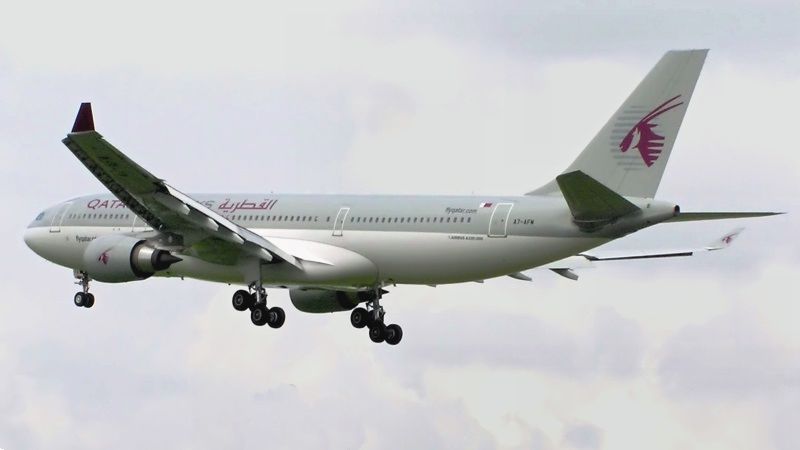
Another visible recognition feature that distinguished it from the A300 was that the wing center section in the fuselage was "bulged". Exactly why is unclear; possibly it was done to accommodate the heavier landing gear, possibly to add fuel stowage -- maybe both? The A330 also featured a new, advanced glass cockpit with sidestick controls, an electronic flight information system (EFIS), an electronic central aircraft monitor (ECAM) system, and a digital "fly-by-wire (FBW)" flight control system -- that technology being derived from the Airbus A320 single-aisle jetliner.
More powerful turbofans were fitted; customers had a choice of the P&W PW4000, GE CF6-80E1, or Rolls-Royce Trent 700, with thrust ratings in the range of 311 kN (31,750 kgp / 70,000 lbf) to 320 kN (32,650 kgp / 72,000 lbf) each. Passenger capacity was 295 seats in a three-class configuration; 335 seats in a two-class configuration; and 440 seats in a single-class configuration. Door arrangement was much like that of the A300.
___________________________________________________________________
AIRBUS A330-300:
___________________________________________________________________
wingspan:
60.3 meters (197 feet 10 inches)
wing area:
361.6 sq_meters (3,892 sq_feet)
length:
63.69 meters (208 feet 11 inches)
height:
16.83 meters (55 feet 3 inches)
empty weight:
124,500 kilograms (274,500 pounds)
MTO weight:
242,000 kilograms (534,000 pounds)
max speed at altitude:
915 KPH (570 MPH / 495 KT)
cruise altitude:
10,670 meters (35,000 feet)
range, fully loaded:
11,300 kilometers (7,010 MI / 6,100 NMI)
___________________________________________________________________
The A330-300 was followed by a "short" subvariant, the "A330-200", introduced in 1997; note the reversal in numbering sequence. Fuselage length of the A300-200 was cut from 63.69 to 58.82 meters (208 feet 11 inches to 193 feet) and empty weight cut by about 5% -- though MTOW was the same, the -200 having more fuel capacity to extend range by almost 20%. Engine options were as per the -300. Passenger capacity of the -200 was 253 seats in a three-class configuration; 293 seats in a two-class configuration; and 380 seats in a single-class configuration.
An "A330-200F" freighter version was also produced from 2009; CF6 engines were not available as an option for it. No "A330-300F" freighter was built new, but from 2012 Airbus offered yet another P2F program to convert airliners into freighters, with the first conversion handed over to a customer in late 2017. Third parties have also offered freighter conversions.
Corporate / VIP configurations of the A330 have been sold, as the "ACJ330" -- where "ACJ" means "Airbus Corporate Jet" -- and the A330 also ended up in military service, again as discussed below. Airbus is now working on a "Beluga XL" large cargo freighter based on the A330-200F, with Rolls-Royce Trent 700 powerplants, 12% more payload capacity, and fuselage diameter increased by a meter. Five Beluga XLs will be obtained, with initial flight of the first on 19 July 2018. They went into service from 2020; they will not immediately replace the original Beluga, being used instead to handle increased transport workload.
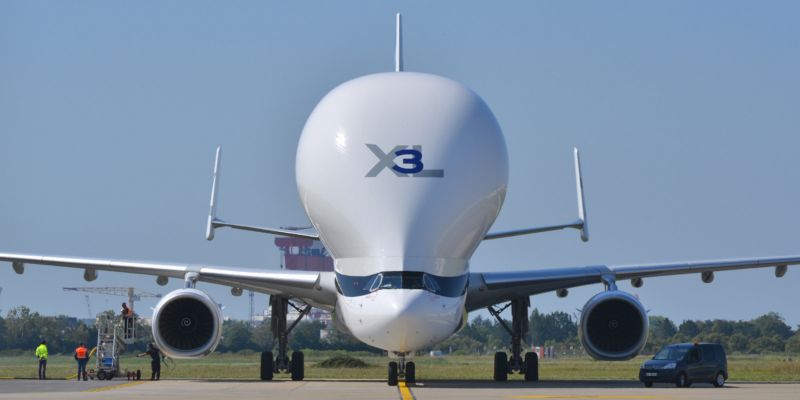
The A330, unlike the A300 and A310, remains in production; a total of over 1,500 A330s had been built by the beginning of 2022. From 2008, Airbus has introduced increased gross weight variants of both the A330-300 and -200 -- with refinements added as well, such as updated avionics and environmental systems, plus more composite airframe assemblies.
Airlines, liking the A330 very much, pushed for an "A330neo" version -- "neo" meaning "new engine option" -- with Airbus committing to development in the summer of 2017. The A330neo series, as introduced, was powered by Rolls-Royce Trent 7000 turbofans; fuel economy per passenger-mile was improved by 14%, and the engines were quieter as well. Two variants were introduced: the "A330-800neo" and "A330-900neo", being re-engined versions of the A330-200 and A330-300 respectively. While the new models retained their old fuselage lengths, internal rearrangement gave a maximum of 6 more seats on the A330-800neo, and 10 more seats on the A330-900neo. A corporate / VIP version, the "ACJ330neo", was put on offer as well. The first-generation A330s were phased out of production.
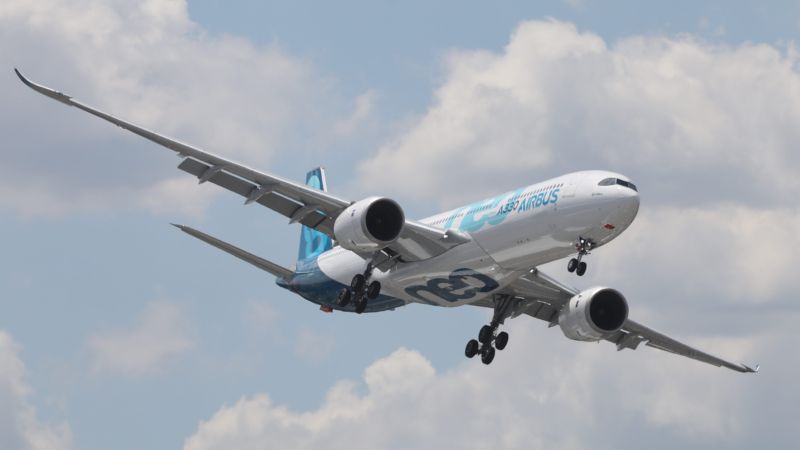
The first of two prototypes, this one being an A330-900neo, performed its initial flight on 19 October 2017, with deliveries beginning a year later. The A330-800neo prototype performed its first flight on 6 November 2018, with deliveries in 2019. An IGW version of the A330-900neo was introduced in 2020. Over a hundred have been delivered to date, with several hundred on order.
BACK_TO_TOP* In parallel with development of the A330, Airbus worked on the "A340", a long-range jetliner of medium capacity, generally similar to the A330 but with four engines instead of two: while North American airlines had no problem with twinjets for long-range operations, Asian airlines preferred four engines, while Europeans were divided on the matter. First flight of the "A340-300" was on 21 October 1991, kicking off a flight test program with six aircraft, including both A340-300 and the shorter "A340-200" variants. Certifications were provided from late 1992 into the spring of 1993, with initial customer deliveries of the A340-300 and A340-200 in early 1993. The initial A340-300 was retained as a trials platform.
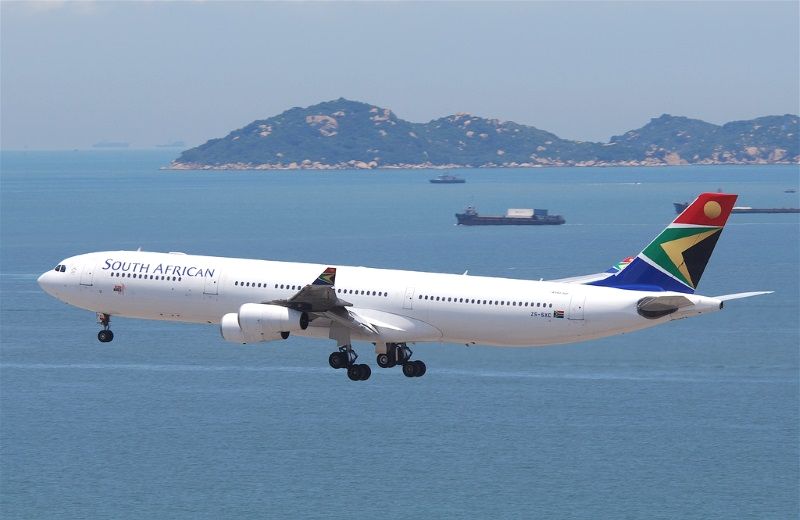
The primary difference between the A340 and the A330 was, as noted, four engines, the -200 and -300 being fitted with GE CFM56-5C engines in the thrust range of 139 kN (14,060 kgp / 31,000 lbf) to 151 kN (15,420 kgp / 34,000 lbf) each. Another noticeable difference was that a third main gear assembly, with twin wheels, was fitted on the centerline, to handle the higher take-off weight. The lengths of the two A340 subvariants were similar to, but not exactly the same, as those of their A330 counterparts:
__________________________________________________________________
A330-200:
59.82 meters (193 feet)
A340-200:
59.39 meters (194 feet 10 inches)
__________________________________________________________________
A330-300:
63.69 meters (208 feet 11 inches)
A340-300:
63.6 meters (208 feet 8 inches)
__________________________________________________________________
It should be noted that, in early concept, the A330 had been the four-jet machine while the A340 was the twinjet machine, but customer feedback suggested it would be less confusing if the four-jet machine were designated the A340. The wing was identical for both the A330 and A340, a common wing having been designed for the A330 and A340 programs. A Honeywell APU was fitted in the tail. Passenger capacity of the A340-200 was typically 240 in a three-class arrangement, 300 in a two-class arrangement, and 375 to 420 in a one-class arrangement. For the A340-300, capacities were 295 in a three-class arrangement, 335 in a two-class arrangement, and 375 to 400 in a one-class arrangement. At least some A340 and, it appears, A330 variants had an option for a crew rest area and other service facilities on the forward lower deck, though specifics are unclear.
The A340-200, due to its relatively small passenger load, was not very popular, with only 28 of them built, a minority featuring additional fuel and high-rated CFM56-5C engines. The A340-300 proved more popular, with an "A340-300E" variant delivered from 1996, featuring higher MTOW and high-rated engines. It led to the late-production "A340-300 Enhanced", with refined engines and a new electronic cockpit.
* In the wake of the A340-200 and A340-300, Airbus considered stretched variants, which emerged as the "A340-500", with a length of 67.9 meters (222 feet 9 inches), and the "A340-600", with a length of 75.3 meters (247 feet 1 inch) -- initial deliveries of both being in 2002. They had wingspan extended to 63.45 meters (208 feet 2 inches) from 60.3 meters (197 feet 10 inches), wing area being increased by over 20%; it is unclear if the new wing involved a change in flight control surface configuration.
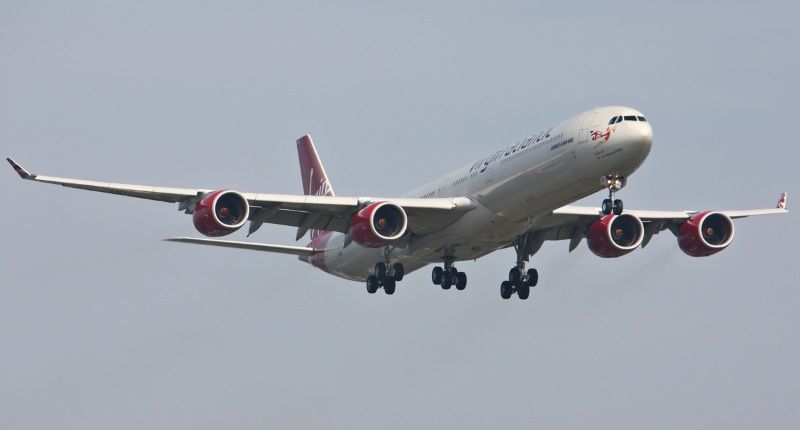
These variants were also powered by Rolls-Royce Trent 500 turbofans, with thrust ranging over variants from 248 kN (25,400 kgp / 56,000 lbf) to 275 kN (28,120 kgp / 62,000 lbf); had a four-wheel, instead of two-wheel, centerline main gear assembly; and a new electronic cockpit, which was also fitted to the A340-300 Enhanced, mentioned above. The A340-600 also added a second passenger door behind the wing, giving ten doors in all, compared to the eight on other A340s and the A330s. Presumably mid-fuselage toilets were a typical fit.
Higher / increased gross weight variants of the A340-500 and A340-600 were delivered from 2006, featuring high-rated Trent 500 engines. A number of "ACJ340" corporate / VIP transport configurations were delivered as well. Some sources mention combi versions of the A340, but it appears this was just a product offering that nobody bought.
The manufacture of the A340 ended in 2011 after 20 years of production, with 377 machines built. That doesn't sound so bad, but it should be noted that in that same year Airbus sold its 7,000th aircraft, so in terms of unit sales it was not a leader.
The bigger problem was that Airbus had taken on risk, selling the A340 to customers with "buy-back" guarantees; in an era of rising fuel prices, ultra-long-range jetliners like the A340 weren't very profitable, since they had to carry so much fuel relative to the passenger load, and ended up burning fuel to carry fuel. Given that the number of passengers requiring such long flights was relatively small, airlines had an incentive to drop very long routes, and fly them in two stages instead.
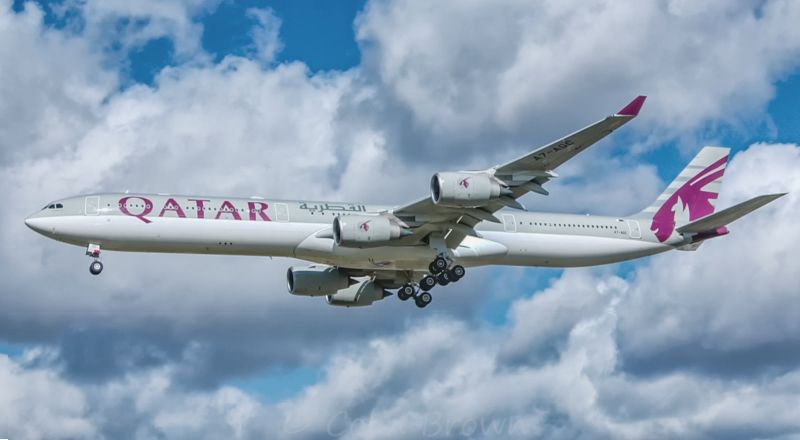
Airlines have generally dumped their A340s, the result being that Airbus has been saddled with used airframes with little sales potential. Notions have been floated for freighter conversions -- but, compared with the A330, due to higher operating costs, the A340 wasn't attractive as an air freighter, either. The A340 is in declining service.
* The A330neo is likely the end of the road for the A300 family, Airbus seeing the advanced A350 and other new jetliners as the future. With the rise in fuel prices, jetliners that were perfectly competitive twenty years ago may be too expensive to operate today, with the result that jetliners with plenty of airframe life left in them go to the wreckers. It seems plausible that even the new generation of jetliners, such as the A350, will have relatively short service lives -- more radical fuel-efficient designs currently on the drawing boards quickly reducing them to obsolescence in turn.
BACK_TO_TOP* There are dozens of military-government users, too many to list, of the Airbus A300 family, typically operating them in jetliner / personnel and VIP transport operations, with few or no changes from civil jetliner configuration aside from the occasional custom luxury interior fit, the machines often being obtained used from the civil market. However, a number of military services have obtained the A310-300 or A330-200 in more specifically military configurations:
In addition, the MRTT had lighting and day-night cameras to support tanker operations, with an operator's station in the cockpit. Both the MRT and MRTT could be kitted up with receivers for inflight refueling. They had military-class navigation and communications kit, including a Link-16 datalink, and it appears typically had a defensive countermeasures system.
* The German Luftwaffe obtained seven used A310-300s in the 1990s -- three from the East German state airline Interflug, which effectively ceased to exist after re-unification, and four from the German Lufthansa airline. One of the Interflug machines remained in service as a personnel transport, while the other two were kitted up as VIP machines; in 2014, one of the VIP machines was converted to a zero-gee research aircraft configuration, to be operated by the German aerospace agency DLR and the French space agency CNES.
The four Lufthansa machines were converted to MRTs later in the decade, with 214 seats in an all-passenger configuration, or 57 seats in the rear and 12 pallets forward in combi configuration. The passenger space could also be configured for MEDEVAC operations. All four were then converted to MRTTs after the turn of the century, featuring an HDU under each wing.
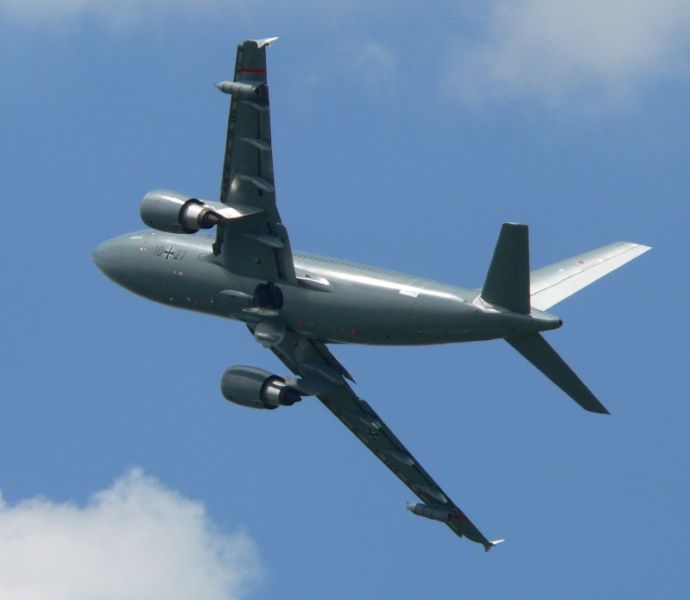
Five used Airbus A310-300s were obtained in the late 1990s by the Royal Canadian Air Force (RCAF), replacing the Boeing 707 in the personnel / VIP transport role, providing more capacity and proving much more fuel-efficient. These machines were given the designation of "CC-150 Polaris", with one being retained in jetliner configuration as a VIP transport, the other four being converted to MRT standard.
The CC-150 MRT machines had a slightly different configuration from the Luftwaffe MRTs, with up to 194 seats in an all-passenger configuration, or 60 seats and 12 pallets in a combi configuration. They were seen as complementary to the Boeing C-17, a much more capable military cargolifter, four C-17s having been obtained by the RCAF. Two of the CC-150s were later updated to "CC-150T" MRTT configuration, with an HDU under each wing, the first being redelivered in 2008. It is unclear if any of these aircraft had inflight refueling receivers.
* The A310 becoming old news, the focused shifted to the A330 MRTT. Australia was the first customer, ordering what would end up being a total of seven from 2005, with deliveries in 2011:2012. The Aussie MRTTs were designated "KC-30A"; they had underwing HDUs, a centerline boom, and were powered by GE CF6-80F turbofans. They could carry a maximum of 270 passengers; or 100 passengers, 40 stretcher, and 20 medical staff; or up to 34 tonnes (37 tons) of cargo, in the lower deck. One was kitted up to act as a VIP transport as a secondary mission. From 2020, Airbus performed an upgrade on their communications and mission systems.
Britain had considered obtaining the A300 for a strategic airlift requirement in the late 1990s, but acquired the C-17 instead. However, in 2000 the UK set up a "Future Strategic Tanker Aircraft (FSTA)" program, to obtain a replacement for the British Royal Air Force's (RAF) aging Vickers VC10 and Lockheed Tristar tankers. In 2004, the A330 MRTT was selected as the solution, with a lease deal for 14 machines signed in 2008, introduction to service in 2011, and final deliveries in 2016.
The RAF MRTTs were based on the A330-200 and have Rolls-Royce Trent 700 engines; there were two subvariants, the "Voyager KC2" with two underwing HDUs, the "Voyager KC3" adding a centerline HDU for a total of three. The Voyagers are actually operated for the RAF by a commercial firm named AirTanker and may be leased by third parties, if they are not committed to operations at the time.
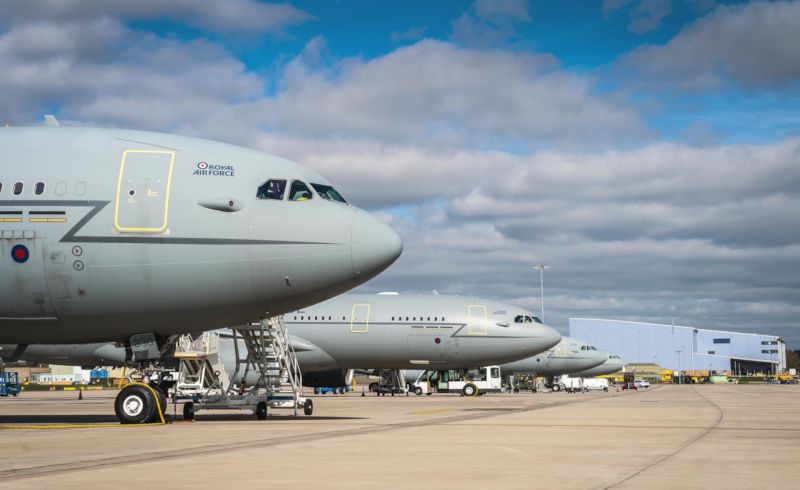
It appears the UK was the only A330 MRTT operator to obtain two-point and three-point HDU configurations. All other operators specified three-point refueling with a centerline boom system, as per the Australian KC-30As:
It appears that at least some of these aircraft were kitted up as receivers for inflight refueling. Later deliveries were in an "MRTT Enhanced" AKA "New Standard Definition" configuration, matching updated A330 commercial production, featuring structural and aerodynamic changes, slightly greater fuel efficiency, and improved avionics / military systems. First flight of an MRTT Enhanced machine was in 2016; Singapore's initial orders were the first to be delivered in the MRTT Enhanced configuration. Some users with earlier machines are having them updated. However, at last notice Airbus was not offering an A330neo-based MRTT -- though the end of production of the first-generation A330s means it's likely to happen.
Specific enhancements in the works include:
Other work in progress is to use the MRTT as a communications node, carrying battlefield relay or high-bandwidth satellite communications gear. The British RAF has experimented with this concept under the BABEL FISH VII effort, leveraging off earlier efforts to get different platforms to talk to each other.
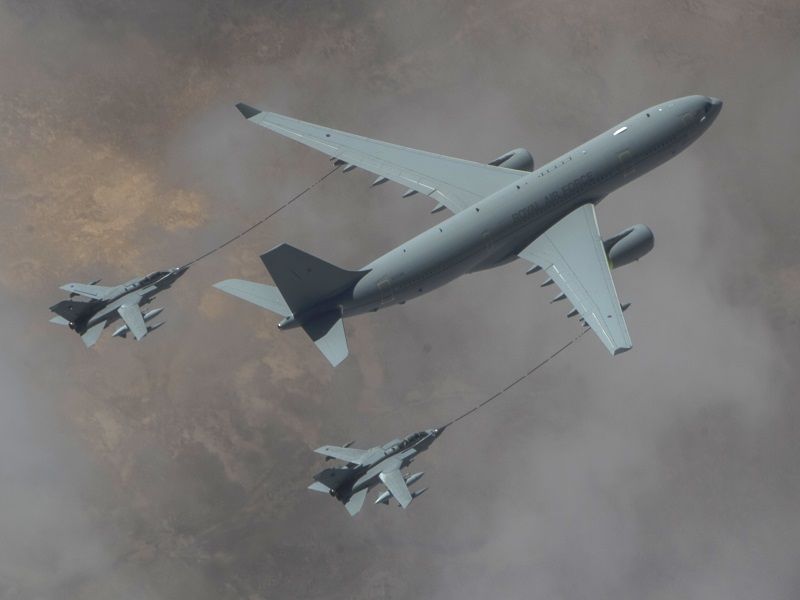
The A330 was offered to the US Air Force for the service's KC-X future tanker program, the type being designated "KC-45", with Northrop Grumman as the American partner. The competition was the Boeing "KC-46", based on the Boeing 767. The KC-45 won the competition in 2008, but Boeing successfully challenged the award, forcing the USAF to restart the competition. The KC-46 won the second round in 2011. The story of this exercise is too painful and ugly to want to investigate here.
BACK_TO_TOP* One interesting item concerning the Airbus jetliners was a proposal by Swiss Space Systems (S3) of Payerne, Switzerland, to use an A300 as the first stage of a robot spaceplane, the "Sub-Orbital Aircraft Reusable (SOAR)" vehicle. The A300 would carry the SOAR spaceplane to 10,000 meters (33,000 feet) on its back for launch, with SOAR then flying to an altitude of 80 kilometers (50 miles). At the top of its arc, SOAR would release an "upper stage" to put a small satellite into orbit, and then return to Earth for re-use.
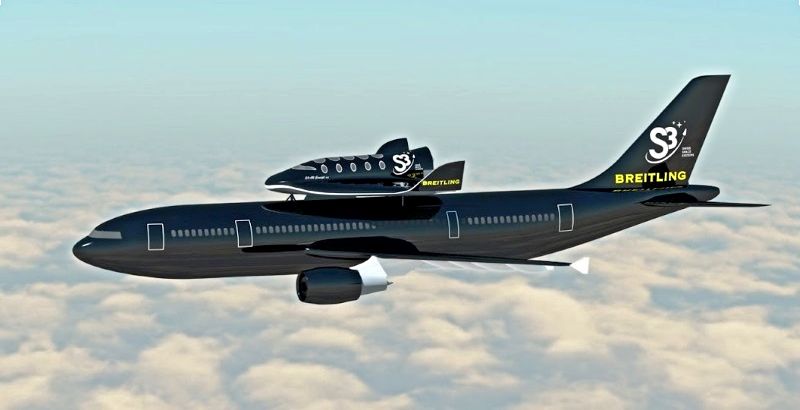
SOAR would be able to place about 250 kilograms (550 pounds) of payload into low Earth orbit. Similar space projects have been floated for decades with little result; when it comes to spacelift concepts, many are called, but few are chosen.
* Sources include:
The online Wikipedia and several volumes of JANE'S ALL THE WORLD'S AIRCRAFT were also consulted.
* Illustrations details:
* Revision history:
v1.0.0 / 01 apr 14 v1.1.0 / 01 mar 16 / Considerable cleanup and correction. v1.2.0 / 01 may 18 / Review & polish, cleanup on freighter conversions. v1.2.1 / 01 apr 20 / Review, update, & polish. v2.0.0 / 01 mar 22 / Review, update, & polish. v2.1.0 / 01 feb 22 / Review, update, & polish. (+)BACK_TO_TOP
